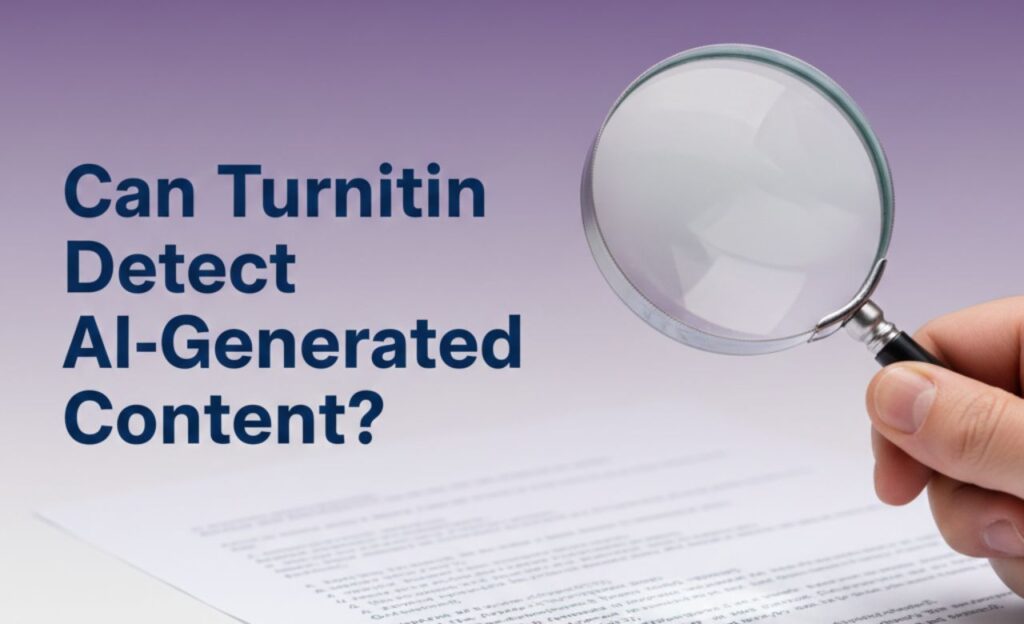Understanding Turnitin and AI Detection
Can Turnitin Detect ChatGPT? – Yes, Turnitin can now flag AI-written text, including content generated by ChatGPT, using AI-detection algorithms that analyze writing patterns, sentence structure, and predictability.
These enhancements allow instructors to check submitted papers not only for copied material but also for machine-generated writing.
How Does Turnitin Detect ChatGPT Content?
Turnitin’s AI detection system analyzes multiple factors to identify AI-generated text:
- Pattern Recognition: Turnitin looks for patterns typical of AI writing, such as unusual phrase structure, repetitive vocabulary, and balanced sentence styles that often differ from human writing.
- Perplexity and Burstiness: These metrics review how surprising and varied the text is. AI output often exhibits less variability in sentence length and complexity, while human writing is more mixed and unpredictable.
- Database Comparison: Beyond structural analysis, Turnitin checks work against extensive databases of academic papers and known AI-generated content to spot similarities or paraphrasing.
- Segment Analysis: Turnitin divides documents into segments and examines each for signs of machine-generation. It focuses primarily on prose text and ignores bullet points, tables, or code blocks.
- AI Paraphrasing Detection: The tool can also spot AI-paraphrased materials, even if the original output was rewritten or reworded by another AI tool.
- Color-Coded Reports: Turnitin provides instructors with a clear breakdown (using colored flags and percentages) showing the portions of text it deems likely to be AI-generated.
What Parameters Does Turnitin Check to Flag AI Content?
Below are the main parameters and signals Turnitin uses:
- Sentence Structure and Uniformity: AI writing tends to be evenly balanced with frequent use of conjunctions like “Moreover,” “Additionally,” and “Therefore,” producing a tone that is consistent and sometimes unnatural.
- Repetitiveness: Machine-generated text often features repeated use of academic jargon, formulaic arguments, and phrases that sound similar across paragraphs.
- Predictability Metrics: The AI examines statistical signals—how likely certain words or phrases are to appear next—since AI writing is often more predictable given its training on large datasets.
- Linguistic Patterns: Turnitin uses proprietary models trained on actual AI and human writing, searching for telltale signs like coherence, construction, and variation in sentence length.
- Perplexity: Measures how unexpected a sentence is. Higher perplexity is associated with human writing, while AI tends toward lower perplexity due to more uniform word choice.
- Burstiness: Assesses how sentence complexity fluctuates. Human writing fluctuates more, so high burstiness signals natural authorship.
- AI Paraphrasing Detection: Flags text that has been reworded by AI even if the phrasing is altered.
- Qualifying Text: Only analyzes text that is prose organized in clear paragraphs, ignoring tables, lists, and code blocks.
Accuracy and Limitations of Turnitin’s AI Detection
While Turnitin’s AI detection feature is sophisticated, it is not foolproof:
- False Positives: The tool can sometimes wrongly flag human-written work as AI-generated, especially if the writing style is formal, repetitive, or non-native English.
- Reliability: Scores between 1-19% are considered unreliable with a higher chance of false positives, and Turnitin only flags content with greater certainty when more than 20% of qualifying text is suspected of being AI-generated.
- Evolving Capabilities: As AI models like GPT-5 and Claude 3 become more advanced and “human-like,” Turnitin struggles to keep up but regularly updates its detection models.
- Paraphrased Content: Heavily reworded AI-generated content is harder for Turnitin to detect accurately.
Ethical Use and Academic Integrity
The rise of AI writing tools raises significant ethical questions around academic integrity. While Turnitin’s reports help educators spot suspicious AI-written sections, institutions recommend treating results as indicators rather than conclusive proof of misconduct—human review and student dialogue remain essential.
False positives can impact grades, reputations, and opportunities, so understanding both the strengths and weaknesses of Turnitin’s AI detection is crucial.
Making Your Content Plagiarism-Free and Human-Like
To avoid detection as AI-generated, use the following tips:
- Mix Up Your Sentences: When you write, try using different sentence lengths. Some can be short and snappy, while others can be longer and more detailed. This keeps your writing interesting and fun to read.
- Share Your Stories: Think about adding personal stories or examples to your writing. This makes your work more relatable and helps people understand your point of view better.
- Keep It Fresh: Avoid using the same words or phrases over and over again. Also, try not to use too many big, fancy words that might confuse people. Keep it simple and clear.
- Make It Your Own: When you use AI to help with writing, make sure to change it up a lot. Add your own style and voice so it sounds like you.
- Show Your Work: Keep track of your writing process. Save your drafts and notes. This way, you can show how you came up with your ideas if anyone asks.
- Check Your Work: Before you finish, make sure to check your writing for any signs that it might look like it was copied or done by a computer. This helps keep your work original and honest.
Conclusion
Turnitin can detect ChatGPT-generated content with notable accuracy, using proprietary AI models trained on linguistic and structural patterns unique to machine-generated writing.
It analyzes perplexity, burstiness, repetitiveness, and overall structure, but is not infallible—false positives and limitations exist, especially with evolving AI capabilities.
Writers can minimize detection risk by producing highly original, personalized content, and educators should interpret Turnitin’s findings within a broader context to support fair academic evaluation.

